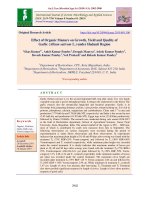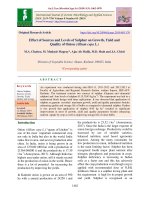Response of growth, yield and quality parameters of foxtail millet genotypes to different planting density
Bạn đang xem bản rút gọn của tài liệu. Xem và tải ngay bản đầy đủ của tài liệu tại đây (394.43 KB, 9 trang )
Int.J.Curr.Microbiol.App.Sci (2019) 8(2): 1765-1773
International Journal of Current Microbiology and Applied Sciences
ISSN: 2319-7706 Volume 8 Number 02 (2019)
Journal homepage:
Original Research Article
/>
Response of Growth, Yield and Quality Parameters of Foxtail Millet
Genotypes to Different Planting Density
K.M. Nandini* and S. Sridhara
Department of Agronomy, University of Agricultural and Horticultural Sciences,
Shivamogga (Karnataka), India
*Corresponding author
ABSTRACT
Keywords
Foxtail millet,
Spacing,
Genotypes, Growth,
Yield, and Quality
Article Info
Accepted:
15 January 2019
Available Online:
10 February 2019
A field trial was conducted to standardize row spacing and suitable genotype of foxtail
millet to Southern Transition Zone of Karnataka at College of Agriculture, Shivamogga.
Three foxtail millet genotypes viz., Local, HMT-1 and SIA 2644 were grown at four
different spacing viz., 30 cm x 10 cm, 20 cm x 10 cm, 20 cm x 5 cm and10 cm x 5 cm.
Experiment was laid out in factorial Randomized complete block design with three
replications. The pooled results of the experiment shows that Among the different spacing,
plants grown at 20 cm x 10 cm recorded significantly higher plant height (100.50 cm),
number of leaves (35.14), number of tillers hill -1 (14.43), number of productive tillers hill-1
(12.19), test weight (3.48 g), panicle length (16.26 cm), panicle weight (4.38 g) and grain
yield (2227 kg ha-1), straw yield (4349 kg ha-1) and quality parameters viz., Protein (10.08
%) and fibre (6.33 %), as compared to other planting density. Among the genotypes, SIA
2644 recorded significantly higher growth parameters viz., plant height (86.90 cm),
number of leaves (30.64), number of tillers hill -1 (11.55), number of productive tillers hill-1
(9.76), test weight (3.26 g), panicle length (14.29 cm), panicle weight (3.79 g) and grain
yield (1941 kg ha-1), straw yield (3919 kg ha-1) and quality parameters viz., Protein (10.08
%) and fibre (6.33 %), as compared to other genotypes. The combined effect of 20 cm x 10
cm + SIA 2644 was recorded significantly higher growth, yield and quality parameters as
compared to other treatments.
Introduction
Millets are a group of highly variable smallseeded grass, widely grown around the world
as cereal or grain crops for human food and
animal fodder. In recent years, there has been
an increasing recognition of the importance of
millets as a substitute for major cereal crops.
Millets have the potentiality of contributing to
increased food production both in developing
and developed countries. Millets are known
for their climate-resilient features including
adaptation to a wide range of ecological
conditions, less irrigational requirements,
better growth and productivity in low nutrient
input conditions, less reliance on synthetic
fertilizers, and minimum vulnerability to
environmental stresses (Kole et al., 2015).
Also, millets are nutritionally superior to
other major cereals as they are rich in dietary
fibers, resistant starches, vitamins, essential
amino acids, storage proteins and other
1765
Int.J.Curr.Microbiol.App.Sci (2019) 8(2): 1765-1773
bioactive compounds (Amadou et al., 2013).
These attributes have made millets a crop of
choice for cultivation in arid and semi-arid
regions of the world; however, the less
attempt has been made to study the climateresilient features of millets compared to other
major cereals. Among millets, foxtail millet
(Setaria italica) and its wild progenitor, green
foxtail (S. viridis) are extensively studied
since they are considered as models for
studying the traits related to C4
photosynthesis, stress biology, and bioenergy
characteristics (Muthamilarasan and Prasad,
2015). In India, Andhra Pradesh (4,79,000
ha), Karnataka (2,32,000 ha) and Tamilnadu
(20,000 ha) are the major foxtail millet
growing states contributing about 90 per cent
of the total area under cultivation. Andhra
Pradesh is a major foxtail millet growing state
contributing about 79 per cent of the total
area. However, the productivity of foxtail
millet found to be very low as compared to
that of finger millet due to the lack of suitable
genotypes, as well as production packages.
Crop production is greatly affected by
climatic factors (rainfall and temperature),
soil factors and cultural practices (e.g. sowing
date, seed rate, plant spacing, sowing
methods, weeding and harvesting methods).
Among the various management factors
contributing to growth and development of
foxtail millet, non-monetary inputs like time
of sowing, row spacing and selection of
variety play vital role in increasing crop
productivity. Cultivation of plants with
desirable density has positive effect on crop
yield components, so that the suitable yield
will be achieved by optimum plant density
(Ullah et al., 2005). The optimum plant
population which exerts near maximum
pressure to exploit environmental resources to
the fullest extent there by leading to higher
yield of crop. However, maintenance of
optimum planting density is always a big
problem to the farmers and they maintain
substandard plant density, results in high
weeds infestation, poor radiation use
efficiency and low yield, while dense plant
population on the other hand may cause
lodging, poor light penetration in the canopy,
reduce photosynthesis due to shading of lower
leaves and drastically reduce the yield
(Pradhan
and
Mishra,
1994).
The
investigation on this aspect has clearly
indicated that the population density in foxtail
millet needs to be adjusted as per growth
habit of variety, sowing time, prevailing agro
climatic conditions. Thus there is a need to
work out optimum population density by
adjusting inter and intra-row spacing in
relation to sowing time and other agronomic
factors.
Materials and Methods
The experiment was conducted to evaluate the
performance of foxtail millet (Setariaitalica
L.) genotypes with different spacing at
ZAHRS, University of Agricultural and
Horticultural Science, Shivamogga, during
Kharif 2016 and 2017. The soil of experiment
site was on a red sandy clay soil with clay
(35.8 %), silt (7.1 %), fine sand (57.1 %).
Experiment was laid out in factorial
Randomized Complete Block Design (RCBD)
with replicated thrice. The plot size of 3.6 m x
3.0 m was used. The sowing was carried out
in respective plots in second week of June
2016 and 2017 according to the treatments.
Recommended fertilizer was applied in the
seed furrows open manually and it was mixed
thoroughly in to the soil before sowing.
Recommended dose of fertilizer NPK kg ha-1
was added to the well prepared area. Urea and
single Super phosphate were used as source of
nutrients. Optimum plant population was
maintained by thinning after 15 days of
sowing. All other agronomic practices were
kept normal and uniform. Biometric
observations like plant height was measured
from base of the stem at ground level to the
tip of the main shoot having fully opened top
1766
Int.J.Curr.Microbiol.App.Sci (2019) 8(2): 1765-1773
leaf and number of fully opened green leaves
and number of tillers were recorded from the
five healthy plants in each plot at 20, 40, 60
days after sowing and at harvest. Yield
parameters like panicle length, panicle weight
and test weight was recorded from the five
randomly selected plants at the time of
harvest. Panicle length was measured from
the base of the Panicle to tip of the Panicle
and expressed as Panicle length in centimeters
(cm). A grain yield and straw yield of foxtail
millet was obtained from net plot is computed
for hectare and expressed in kilogram hectare1
. Harvest index was determined by dividing
the total grain yield by the total biological
yield and expressed as % following Donald
(1962).
Economic yield (kg ha-1)
Harvest index (HI)
=
Biological yield (kg ha-1)
Quality parameters
Crude protein content of grain (%)
Nitrogen content in the grain was determined
by Kjeldal Method as described by Jackson
(1973) and expressed in percentage. The
crude protein content was worked out by
multiplying the nitrogen percentage with
factor 6.25 (Doubetz and Wells, 1968).
Crude protein (%) = N content in grain (%) ×
6.25.
Crude fibre content of grain (%)
Crude fibre content was estimated by the
acid-alkali digestion method. The residue
obtained after digestion was dried in a
crucible and its weight was recorded (We).
The dried residue was then ashed in a muffle
furnace at 600°C for 3 to 4 hours and its
weight (Wa) was recorded. The difference
between these two weights (We - Wa) was
taken as the weight of the crude fibre
(Mahadevan 1965).
Crude fibre (%)
=
We - Wa
Weight of sample
× 100
Results and Discussion
Effect of spacing, genotypes and their
interaction on growth parameters of foxtail
millet
Number of functional leaves per plant is a
product of plant height and number of tillers
per plant. In the present study 20 cm× 10 cm
produced taller plants (100.50 cm) with more
number of tillers (14.43) at harvest (Table 1).
These results are in conformity with the
Kalaraju et al., (2009) in pearl millet. Who
has also noticed increased plant height and
number of tillers in turns increased the
number of leaves. 20 cm× 10 cm produced
more number of leaves (35.14 hill-1) at 60
DAS (Table 1) than other spacing. Genotypes
exhibited significant difference with respect
to plant height from 20 DAS to harvest.
Significantly higher plant height of 86.90 cm
at harvest and higher number of functional
leaves (30.64) was recorded with genotype
SIA 2644 as compared with HMT-1 and
local(Table 1) due to genetic makeup of
genotypes. These results are in confirmity
with the findings of Makkhanlal et al., (2007)
and Michael et al., (2016) in pearl millet,
Misra et al., 1973 in ragi.
Genotypes had more influence on yield of
foxtail millet through higher tillering ability
and it is one of the most important desirable
factors for increased yield potential in rainfed
varieties. Tillering capacity varied with
genotypes and its producing ability is
dependent on dry matter production and
accumulation in main stem during the early
stage of the growth (Michael et al., 2016 in
pearl millet). In present study also, higher
number of tillers was recorded in SIA 2644
(11.55) followed by HMT-1 (10.72) and
Local (9.51) at harvest (Table 1).
1767
Int.J.Curr.Microbiol.App.Sci (2019) 8(2): 1765-1773
Table.1 Plant height (cm), Number of leaves hill-1 and Number of tillers hill-1 at harvest of foxtail millet as influenced by spacing and
genotypes
Treatments
2016
Spacing
S1:30 cm × 5 cm
S2:20 cm × 5 cm
S3:20 cm × 10 cm
S4:10 cm × 5 cm
F test
S.Em±
C.D.(p=0.05)
Genotypes
G1:Local
G2:HMT-1
G3:SIA 2644
F test
S.Em±
C.D.(p=0.05)
S×G
S1G1
S1G2
S1G3
S2G1
S2G2
S2G3
S3G1
S3G2
S3G3
S4G1
S4G2
S4G3
S.Em±
Plant height (cm)
2017
Pooled
Number of leaves hill-1
2016
2017
Pooled
Number of tillers hill-1
2016
2017
Pooled
83.35
75.04
96.17
63.71
*
1.79
5.26
90.85
81.79
104.82
69.44
*
1.30
3.81
87.10
78.41
100.50
66.57
*
1.37
4.01
31.16
24.76
33.31
21.30
*
0.74
2.17
34.58
27.48
36.97
23.64
*
0.79
2.33
32.87
26.12
35.14
22.47
*
0.77
2.25
11.56
8.93
13.93
5.79
*
0.31
0.90
13.02
10.06
14.94
6.52
*
0.32
0.94
12.29
9.50
14.43
6.15
*
0.31
0.92
75.91
79.62
83.16
*
1.55
4.55
82.75
86.78
90.65
*
1.12
3.30
79.33
83.20
86.90
*
1.18
3.47
28.02
29.04
25.82
*
0.64
1.88
31.10
32.24
28.66
*
0.69
2.02
27.74
29.56
30.64
*
0.66
1.95
8.94
10.22
10.99
*
0.27
0.78
10.07
11.23
12.10
*
0.28
0.82
9.51
10.72
11.55
*
0.27
0.80
80.84c-f
83.96c-e
85.24cd
71.18f-h
74.33e-g
79.60d-f
90.24bc
96.25ab
102.01a
61.40h
63.92h
65.80gh
3.10
88.12d
91.52cd
92.91cd
77.58fg
81.03ef
86.76de
98.36bc
104.92ab
111.19a
66.93h
69.67h
71.72gh
2.25
84.48de
87.74cd
89.08cd
74.38fg
77.68ef
83.18de
94.30bc
100.59ab
106.60a
64.16h
66.80h
68.76gh
2.37
31.92c
33.08bc
34.92a-c
23.20d-f
24.66de
26.41d
36.61ab
37.21a
19.66f
20.36f
21.23ef
22.31ef
1.28
35.43c
36.72bc
38.76a-c
25.75d-f
27.38de
29.32d
40.64ab
41.30a
21.82f
22.60f
23.56ef
24.77ef
1.37
33.67c
34.90bc
36.84a-c
24.47d-f
26.02de
27.86d
38.62ab
39.25a
20.74f
21.48f
22.39ef
23.54ef
1.33
10.89d-f
11.61c-e
12.19cd
7.06g
9.29f
10.45ef
12.77bc
13.93ab
15.09a
5.05h
6.06gh
6.26gh
0.53
12.27cd
13.07b-d
13.73bc
7.96f
10.46e
11.77de
14.38ab
14.57ab
15.87a
5.68g
6.82fg
7.05fg
0.56
11.58de
12.34c-e
12.96b-d
7.51g
9.87f
11.11ef
13.57bc
14.25ab
15.48a
5.36h
6.44gh
6.65gh
0.54
1768
Int.J.Curr.Microbiol.App.Sci (2019) 8(2): 1765-1773
Table.2 Grain yield (kg ha-1), straw yield (kg ha-1) and harvest index of foxtail millet as influenced by spacing and genotypes
Treatments
Spacing
S1:30 cm × 5 cm
S2:20 cm × 5 cm
S3:20 cm × 10 cm
S4:10 cm × 5 cm
F test
S.Em±
C.D.(p=0.05)
Genotypes
G1:Local
G2:HMT-1
G3:SIA 2644
F test
S.Em±
C.D.(p=0.05)
S×G
S1G1
S1G2
S1G3
S2G1
S2G2
S2G3
S3G1
S3G2
S3G3
S4G1
S4G2
S4G3
S.Em±
Grain yield (kg ha-1)
2016
2017
Pooled
Straw yield (kg ha-1)
2016
2017
Pooled
2016
Harvest index
2017
Pooled
1632
1676
2146
1562
*
32.18
94.37
2024
1803
2308
1679
*
35.91
105.31
1953
1740
2227
1621
*
27.44
80.49
3966
3632
4268
3410
*
37.75
110.71
4007
3641
4430
3442
*
40.38
118.44
3986
3637
4349
3426
*
32.26
94.63
0.32
0.32
0.33
0.31
NS
0.006
-
0.34
0.33
0.34
0.33
NS
0.006
-
0.33
0.32
0.34
0.32
NS
0.006
-
1762
1818
1871
*
27.87
81.73
1894
1955
2012
*
31.10
91.20
1828
1886
1941
*
23.77
69.71
3741
3844
3871
*
32.69
95.87
3787
3888
3966
*
34.97
102.57
3764
3866
3919
*
27.94
81.95
0.32
0.32
0.32
NS
0.005
-
0.33
0.33
0.34
NS
0.005
-
0.33
0.33
0.33
NS
0.005
-
1827c-e
1872cd
1948bc
1641fg
1675e-g
1713d-f
2079ab
2148a
2212a
1499g
1575fg
1611fg
55.73
1965c-e
2013cd
2095bc
1765fg
1801e-g
1842d-f
2235ab
2310a
2378a
1612g
1694fg
1732fg
62.19
1896cd
1943c
2022bc
1703ef
1738e
1778de
2157ab
2229a
2295a
1556f
1635ef
1671ef
47.53
3856de
3969cd
4072bc
3562fg
3635fg
3700ef
4202ab
4261ab
4340a
3283h
3434gh
3511fg
65.38
3930c
4006c
4085c
3583de
3638de
3702d
4314b
4435ab
4542a
3321f
3473ef
3533d-f
69.94
3893d
3987cd
4079c
3572e-g
3636ef
3701e
4258b
4348ab
4441a
3302h
3454gh
3522fg
55.88
0.32a
0.32a
0.32a
0.32a
0.32a
0.32a
0.33a
0.33a
0.34a
0.31a
0.31a
0.31a
0.010
0.33a
0.33a
0.34a
0.33a
0.33a
0.33a
0.34a
0.34a
0.34a
0.33a
0.33a
0.33a
0.010
0.33a
0.33a
0.33a
0.32a
0.32a
0.32a
0.33a
0.34a
0.34a
0.32a
0.32a
0.32a
0.010
1769
Int.J.Curr.Microbiol.App.Sci (2019) 8(2): 1765-1773
Table.3 Yield components of foxtail millet as influenced by spacing and genotypes
Treatments
Spacing
S1:30 cm × 5 cm
S2:20 cm × 5 cm
S3:20 cm × 10 cm
S4:10 cm × 5 cm
F test
S.Em±
C.D.(p=0.05)
Genotypes
G1:Local
G2:HMT-1
G3:SIA 2644
F test
S.Em±
C.D.(p=0.05)
S×G
S1G1
S1G2
S1G3
S2G1
S2G2
S2G3
S3G1
S3G2
S3G3
S4G1
S4G2
S4G3
S.Em±
Productive tillers hill-1
2016
2017
Pooled
Panicle length (cm)
2016
2017 Pooled
2016
9.83
7.59
11.84
4.92
*
0.26
0.77
10.94
8.45
12.55
5.47
*
0.27
0.79
10.38
8.02
12.19
5.20
*
0.27
0.78
13.85
12.11
15.56
10.31
*
0.29
0.85
15.10
13.20
16.96
11.23
*
0.29
0.85
14.47
12.65
16.26
10.77
*
0.29
0.85
3.75
3.21
4.28
2.84
*
0.10
0.28
3.92
3.35
4.47
2.96
*
0.10
0.28
3.83
3.28
4.38
2.90
*
0.10
0.28
3.22
3.04
3.41
2.84
*
0.10
0.28
3.35
3.17
3.55
2.95
*
0.10
0.28
3.28
3.10
3.48
2.89
*
0.10
0.28
7.60
8.69
9.35
*
0.23
0.66
8.46
9.43
10.17
*
0.23
0.69
8.03
9.06
9.76
*
0.23
0.67
12.22
12.97
13.68
*
0.25
0.74
13.32
14.14
14.91
*
0.25
0.74
12.77
13.56
14.29
*
0.25
0.74
3.35
3.50
3.71
*
0.08
0.24
3.50
3.66
3.87
*
0.08
0.24
3.42
3.58
3.79
*
0.08
0.24
3.06
3.13
3.19
*
0.08
0.24
3.19
3.25
3.32
*
0.08
0.24
3.12
3.19
3.26
*
0.08
0.24
9.26d-f
9.87c-e
10.36cd
6.01g
7.89f
8.88ef
10.85bc
11.84ab
12.83a
4.29h
5.15gh
5.32gh
0.45
10.31cd
10.98b-d
11.53bc
6.68f
8.78e
9.88de
12.08ab
12.24ab
13.33a
4.77g
5.73fg
5.92fg
0.47
9.78de
10.42c-e
10.94b-d
6.34g
8.34f
9.38ef
11.47bc
12.04ab
13.08a
4.53h
5.44gh
5.62gh
0.46
13.06cd
14.01bc
14.49bc
11.05ef
12.33de
12.94cd
14.87ab
15.44ab
16.39a
9.91f
10.12f
10.89ef
0.50
14.23cd
15.27bc
15.79b
12.04ef
13.44de
14.10cd
16.20b
16.83ab
17.86a
10.80f
11.03f
11.87f
0.50
13.65c-e
14.64b-d
15.14bc
11.55fg
12.88ef
13.52de
15.53b
16.13ab
17.12a
10.36g
10.58g
11.38fg
0.50
3.62c-e
3.74cd
3.89b-d
3.07fg
3.12e-g
3.43d-f
4.02a-c
4.3ab
4.52a
2.68g
2.85g
2.98fg
0.17
3.78cd
3.91cd
4.07b-d
3.21ef
3.26ef
3.58de
4.20bc
4.49ab
4.72a
2.80f
2.98f
3.11ef
0.17
3.70c-e
3.82cd
3.98b-d
3.14fg
3.19e-g
3.51d-f
4.11a-c
4.40ab
4.62a
2.74g
2.91g
3.05fg
0.17
3.17a-c
3.21a-c
3.28a-c
2.97a-c
3.05a-c
3.11a-c
3.35ab
3.41a
3.47a
2.76c
2.84bc
2.91a-c
0.17
3.30a-d
3.34a-d
3.41a-d
3.09a-d
3.17a-d
3.23a-d
3.48a-c
3.55ab
3.61a
2.87d
2.95cd
3.03b-d
0.17
3.23a-d
3.27a-d
3.35a-d
3.03a-d
3.11a-d
3.17a-d
3.42a-c
3.48ab
3.54a
2.82d
2.90cd
2.97b-d
0.17
1770
Panicle weight (g)
2017
Pooled
2016
Test weight (g)
2017
Pooled
Int.J.Curr.Microbiol.App.Sci (2019) 8(2): 1765-1773
Table.4 Quality parameters of foxtail millet as influenced by spacing and genotypes
Treatments
Protein per cent
2016
2017
Pooled
Fibre per cent
2016
2017
Pooled
8.36
7.49
9.83
6.28
*
9.09
8.14
10.33
6.82
*
8.73
7.82
10.08
6.55
*
5.82
5.47
6.21
4.74
6.05
5.69
6.46
4.93
5.94
5.58
6.33
4.83
0.29
0.85
0.29
0.85
0.29
0.85
0.11
0.33
0.11
0.33
0.11
0.33
7.54
7.88
8.55
*
0.25
0.74
8.19
8.48
9.12
*
0.25
0.74
7.86
8.18
8.84
*
0.25
0.74
5.36
5.59
5.73
5.57
5.81
5.96
5.47
5.70
5.84
0.10
0.28
0.10
0.29
0.10
0.29
S1G1
S1G2
S1G3
S2G1
S2G2
S2G3
S3G1
S3G2
S3G3
7.91b-e
8.38b-e
8.80b-d
7.26d-g
7.58c-g
7.64c-f
9.08bc
9.52ab
10.88a
8.60b-d
9.11b-d
9.56a-c
7.89de
8.24cd
8.30cd
9.86a-c
10.02ab
11.12a
8.26b-e
8.74b-e
9.18b-d
7.57d-f
7.91c-e
7.97c-e
9.47a-c
9.77ab
11.00a
5.72b-d
5.81a-d
5.94a-c
5.24d-f
5.53c-e
5.65b-d
6.07a-c
6.20ab
6.36a
5.95b-d
6.04a-d
6.18a-c
5.45d-f
5.75c-e
5.87b-d
6.31a-c
6.45ab
6.61a
5.83b-d
5.92a-d
6.06a-c
5.34d-f
5.64c-e
5.76b-d
6.19a-c
6.32ab
6.48a
S4G1
S4G2
S4G3
S.Em±
5.90g
6.04fg
6.89e-g
0.50
6.42e
6.56e
7.49de
0.50
6.16f
6.30f
7.19ef
0.50
4.42g
4.83fg
4.97e-g
0.19
4.59g
5.02fg
5.17e-g
0.20
4.51g
4.92fg
5.07e-g
0.20
Spacing
S1:30 cm × 5 cm
S2:20 cm × 5 cm
S3:20 cm × 10 cm
S4:10 cm × 5 cm
F test
S.Em±
C.D.(p=0.05)
Genotypes
G1:Local
G2:HMT-1
G3:SIA 2644
F test
S.Em±
C.D.(p=0.05)
S×G
Plant height of foxtail millet increased
significantly with the combined effect of 20
cm × 10 cm + SIA 2644 (106.60 at harvest)
(Table 1) and number of tillers hill-1 (15.48 at
harvest), number of leaves hill-1 which was at
par with 20 cm × 10 cm + HMT-1, 20 cm ×
1771
Int.J.Curr.Microbiol.App.Sci (2019) 8(2): 1765-1773
10 cm + local, 30 cm × 5 cm + SIA 2644 as
compared to 10 cm × 5 cm + SIA 2644 (Table
1). The improvement in plant height was due to
interaction effect of spacing and genotype on
proper establishment of crop.
Effect of spacing, genotypes and their
interaction on yield and yield components of
foxtail millet
The results revealed that grain yield and straw
yield was significantly influenced by different
spacing. Among the four spacings, plants grown
with 20 cm× 10 cm spacing recorded
significantly higher grain yield and straw yield
(2,227 and 4,349 kg ha-1, respectively) followed
by 30 cm × 5 cm (1,953 kg ha-1and 3,986 kg ha1
, respectively) and low grain and straw yield
was observed in 10 cm× 5 cm (1,621 and 3,426
kg ha-1, respectively) (Table 2). Harvest index
recorded non-significant with different spacing.
The higher grain yield in 20 cm × 10 cm may be
attributed to higher yield components viz.,
number of productive tillers (12.19 hill-1 at
harvest), panicle length, panicle weight and test
weight (16.26 cm, 4.38 g and 3.48 g,
respectively) (Table 3) Further, (Anon., 1976)
in millets have also reported a functional
relationship in grain yield with various yield
attributes of foxtail millet. Among three
genotypes SIA 2644 recorded significantly
higher grain yield and straw yield (1941.34,
3918.57 kg ha-1, respectively) followed by
HMT-1 (1886.09 and 3866.15 kg ha-1,
respectively) and local (1827.95 and 3763.66 kg
ha-1, respectively) (Table 2). This increase in
grain yield of SIA 2644 may be due to increase
in yield parameters like number of productive
tillers (9.76 hill-1) at harvest, panicle weight
(3.79 g), panicle length (14.29 cm) and test
weight (3.26 g) followed by HMT-1 and Local
(Table 3).
The results of this present investigation are in
conformation with the findings of Khafi et al.,
(2000) in pearl millet. The low yield in other
varieties is due to decreased yield attributes.
The grain yield of foxtail millet due to
interaction effects of spacing and genotype were
found significant and significantly higher grain
and straw yield (2295 and 4441 kg ha-1,
respectively) was recorded with the interaction
of 20 cm × 10 cm + SIA 2644 which was found
to be on par with 20 cm × 10 cm + HMT-1 and
20 cm × 10 cm + local (Table 2). The increase
in grain yield in 20 cm × 10 cm + SIA 2644 and
a positive relationship between spacing and
genotype existed for higher grain yield mainly
because it recorded higher yield parameters
such as higher productive tillers (13.08) (Table
3) at harvest, panicle length (17.12 cm), panicle
weight (4.62 g) and test weight (3.54 g) than
other interaction effects (Table 3). The harvest
index was significantly higher (0.34) with the
interaction of 20 cm × 10 cm + SIA 2644 which
was followed by 20 cm × 10 cm+ HMT-1 and
on par with 30 cm × 5 cm + SIA 2644 (0.33).
The lower harvest index was recorded due to
interaction of10 cm × 5 cm + Local (0.32)
(Table 2). The increase in stover yield with
closer spacing was mainly due to vertically
expansion of plants with higher growth and dry
matter production resulted in higher stover
yield.
Effect of spacing, genotypes and their
interaction on quality parameters of foxtail
millet
Plants grown at spacing of 20 cm× 10 cm
recorded significantly higher quality parameters
of foxtail millet viz.,protein content (10.08 %),
fiber content (6.33 %) followed by 30 cm × 5
cm (8.73 and 5.94 %, respectively) compared to
other spacing (Table 4). Among genotypes, SIA
2644 recorded significantly higher protein
content, fiber content (8.84 and 5.84 %,
respectively) followed by HMT-1 (8.18 and
5.70 %, respectively) and local (7.86 and 5.47
%, respectively) (Table 4). Among the
interactions SIA 2644 with maintaining spacing
20 cm × 10 cm recorded significantly higher
protein content, fiber content (11.00 % and 6.48
%, respectively), and it was found to be on par
with 20 cm × 10 cm with HMT-1, 20 cm × 10
cm with local as compared to other treatments
(Table 4).
1772
Int.J.Curr.Microbiol.App.Sci (2019) 8(2): 1765-1773
References
Anonymous, 1976, Annual progress report,
Dryland and Agriculture project, GKVK,
Bengaluru.
Donald CM.1962. Competition among crop and
pasture plants. Adv. Agron. 15: 1-114.
Doubetz S. and Wells S A. 1968. Relation of
barley varieties to nitrogen fertilization. J
Agric Sci Cambridge. 70(1): 253-256.
Gurunadha Rao Y, Anjanapa M. and Ramireddy
S. 1990. Effect of fertility levels and
spacing on grain yield of Setaria under
rainfed conditions. Andhra Agric J. 37(1):
94-95.
Kalaraju K, Kumar NS, Nagaraja N. and
Ningappa KB. 2009. Effect of methods of
planting on growth and yield of finger
millet genotypes under organic farming.
Res Crops.10: 20-24.
Mahadevan SA. 1965. Laboratory Manual for
Nutrition Research, pp. 56-58.
MakkhanLal, Bora KK, Ramesh Verma and
Yadav PC. 2007, Effect of in situ
moisture conservation on productivity of
pearlmillet in arid regions of Rajasthan
under farmer's conditions. Ann Arid
Zone. 46(1): 91-93.
Michael O, Ishaya K, Joseph A. 2016, Effects
of intra-row spacing of pearl millet
(Pennisetum glaucum L.) and cropping
systems on growth and yields of soybeanpearl millet intercrop, in the Southern
Guinea Savanna Nigeria. Int J Bio Sci.
44:78-99.
Misra A, Patra SS and Patnaik RN. 1973.
Response of ragi (Eleusine coracana L.)
to spacings and nitrogen. Indian J
Agron.18: 264-268.
Moobe, Martha, K. Nyang, Basweti, Getabu,
Mwangi and Ondicho, 2014, Effect of
plant density on growth and grain yield of
finger mille (Eleusine coracana) under
high potential conditions of southwest
Kenya. J Agric Sci. 10(5): 261-268.
Pradhan L. and Mishra SN. 1994. Effect of
cutting management, row spacing and
levels of nitrogen on fodder yield and
quality of oat (Avena sativa L.). Indian J
Agron. 39(2): 233-236.
Shinggu SA, Mahadi MA, Mukhtar and Asala
SW. 2009. Influence of Spacing and Seed
Rate on Weed Suppression in Finger
Millet (Eleucine carocana L. Gaertn). J
Sci Res. 4(4): 267-270.
Tekle, 2014, Determination of inter row spacing
and seed rate on productivity of finger
millet [Eleusine coracana (l.) Gaertn.], at
Jinka, Southern Ethiopia. Int J Res Agri
Sci. 1(3):2348-3997.
Ullah MJ, Karim M, Mia MS, Shamsuddoha M.
and Begum NJ. 2005, Effect of nitrogen
row spacing and potassium uptake pattern
of foxtail millet. Karnataka J Agric Sci.
18(4): 896-902.
Kole C, Muthamilarasan M, Henry R, Edwards
D, Sharma R, Abberton M. 2015.
Application
of
genomics-assisted
breeding for generation of climate
resilient crops: progress and prospects.
Front Plant Sci. 6:563.
Amadou I, Gounga ME, Le GW. 2013. Millets:
nutritional composition, some health
benefits and processing - a review. Emir J
Food Agric. 25:501–508.
Muthamilarasan M, Prasad M. 2015. Advances
in Setaria genomics for genetic
improvement of cereals and bioenergy
grasses. Theor Appl Genet. 128:1–14.
Khafi, HR, Ramani, BB, Mehta, AC. And
Pethani, KV. 2000, Effects of different
levels of nitrogen, phosphorus and
spacing on yield and economics of hybrid
bajra. Crop Res., 20(3): 411-414.
How to cite this article:
Nandini, K.M. and Sridhara, S. 2019. Response of Growth, Yield and Quality Parameters of Foxtail
Millet Genotypes to Different Planting Density. Int.J.Curr.Microbiol.App.Sci. 8(02): 1765-1773.
doi: />
1773

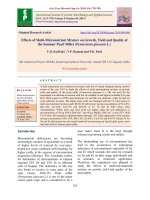
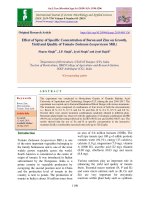
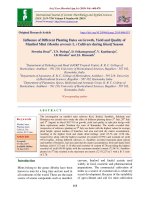
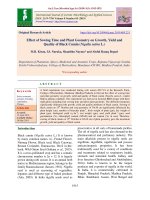
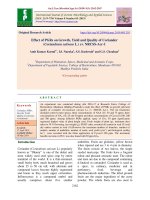
![Studies on correlation and path analysis for grain yield and quality components in foxtail millet [Setaria italica (L.) Beauv.]](https://media.store123doc.com/images/document/2020_01/09/medium_dyd1578574836.jpg)
